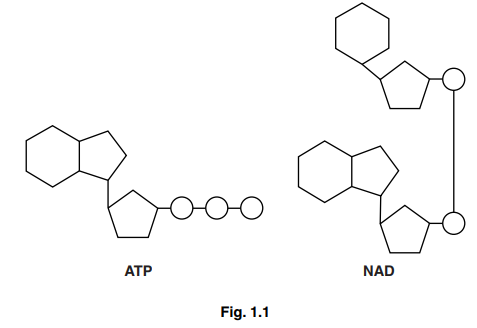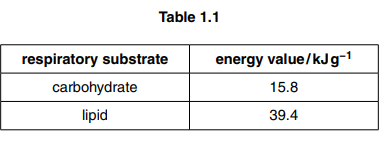Question
(a) Explain the significance of cereal crops in the human diet. [8]
(b) Describe and explain how gibberellins are involved in the germination of wheat or barley seeds. [7] [Total: 15]
Answer/Explanation
Ans:
9 (a) 1 high, carbohydrate/ starch, content ; A 70–80%
2 source of, energy /ATP ;
3 protein provides amino acids ;
4 for growth ;
5 low in fat ; A 2–4%
6 contains essential fatty acids ;
7 source of, vitamin B/ vitamin E ;
8 deficient in, vitamin A/ vitamin D/ vitamin C ;
9 ref. to Golden Rice and vitamin A ; A ref. to other valid examples
10 wide range/AW, of minerals ;
11 named mineral plus use in human body ; e.g. calcium for bone development
12 high in fibre ;
13 for peristalsis/prevents constipation ;
14 easily, dried/ stored ;
15 AVP ; e.g. staple diet for much of the world/named staple crop and location
16 AVP ; e.g. different parts of grain have different nutrients/ref. to processing grain
(b) 1 seed is, dormant/metabolically inactive ;
2 water enters seed ;
3 embryo, produces/releases, gibberellin ;
4 gibberellin stimulates aleurone layer ;
5 (by) affecting, gene coding/transcription of mRNA, for amylase ;
6 to produce amylase ;
7 amylase hydrolyses starch ;
8 in endosperm ;
9 to, maltose/glucose ;
10 embryo uses sugars for respiration ;
11 energy /ATP, used for growth ;
Question
(a) ATP and NAD both play important roles in respiration. Both compounds are nucleotides.
Fig. 1.1 represents the molecular structures of ATP and NAD.

Using Fig. 1.1, compare the structures of ATP and NAD.[3]
(b) ATP provides an immediate energy source for metabolic processes such as anabolic reactions.
State two examples of anabolic reactions in a mammal that require ATP as an energy source.[2]
1
2
(c) Name the type of chemical reaction by which ATP is made during the Krebs cycle.[1]
(d) Outline the roles of NAD in the cytoplasm of a cell.[2]
(e) Carbohydrates and lipids are used as respiratory substrates.
Table 1.1 shows the energy values of carbohydrates and lipids.

Explain why lipids have a higher energy value than carbohydrates. [2] [Total: 10]
Answer/Explanation
Ans:
1 (a) both have ribose (sugars) ; R ribulose
ATP has 1, ribose/ pentose/ sugar, NAD has 2 ; I ref. to additional hexose
both have, adenine/ purine (base) ; I adenosine
NAD has, nicotinamide/ pyrimidine (base) ;
ATP has 3 phosphates, NAD has 2 ;
(b) accept synthesise/ produce/ convert to, for ‘make’ for all mp
make (named), protein/ polypeptide/ peptides ; A protein synthesis / translation
make (named), disaccharide/ oligosaccharide/ polysaccharide/ glycogen ; R non-mammalian examples such as starch or cellulose
make (named), triglycerides / lipids / phospholipids / steroids / cholesterol ;
A glycogenesis
make, nucleotide/ polynucleotide/ nucleic acid/DNA/RNA ;
A transcription/DNA replication
AVP ; e.g. named example of, polymerisation/ condensation
A phosphorylation example
(c) substrate-linked/ substrate-level, phosphorylation ; I condensation reaction
(d) hydrogen, carrier/ acceptor ; A gets reduced or gains H/H+ and electrons I donates R H2/ hydrogen molecules
(acts as a) coenzyme ; A enables dehydrogenases to work
ref. to glycolysis /respiration in anaerobic conditions ; A anaerobic respiration I aerobic
(e) ‘more’ needed once plus implied for second mp
1 more, C-H bonds / hydrogen(s) /reduced ; I C-C bonds
R more hydrogen bonds R hydrocarbons
accept produces / gives /results in for ‘makes’ in mp 2 and mp3
2 (makes) more reduced NAD ;
3 makes more ATP per, gram/ molecule/ mole/ unit mass ;
A releases /results in/ gives, more energy per, g/ etc.
4 more, aerobic respiration/ electron transport chain (ETC) / oxidative
phosphorylation/ chemiosmosis ; A higher rate of for ‘more’
Question
(a) Describe the features of ATP that make it suitable as the universal energy currency. [6]
(b) Outline respiration in anaerobic conditions in mammalian cells and describe how it differs from respiration in anaerobic conditions in yeast cells. [9] [Total: 15]
Answer/Explanation
Ans:
9(a) any six from:
1 (short-term) store of energy ;
2 (energy derived) from, food / respiration / photophosphorylation / chemiosmosis ;
3 transfers energy (to) / (immediate) energy donor (to) ;
4 in all, cells / organisms ;
5 hydrolysis / phosphate loss, releases, energy / 30.5 kJ (per mole) ;
6 reversible reaction / (AMP and) ADP recycled to ATP ;
7 small (molecule) / water soluble, so can move within, cell / cytoplasm ;
8 links energy yielding and energy requiring reactions ;
9 high turnover (rate) ;
and any two uses up to question total of 6 from:
10 active transport / action potential / electrical discharge ;
11 muscle contraction ;
12 anabolic reactions / condensation reactions / transcription / translation / DNA replication / Calvin cycle / phosphorylation
reactions ;
13 exocytosis / endocytosis / intracellular transport ;
14 bioluminescence ;
9(b) any nine from:
anaerobic respiration in, mammalian cells / lactic fermentation (M):
1 pyruvate, is reduced / accepts H / accepts H+ + electron ;
2 (process uses) reduced NAD ;
3 from glycolysis ;
4 converted to, lactate / lactic acid ;
5 ref. to lactate dehydrogenase ;
6 regeneration of NAD allows glycolysis to continue ;
7 small energy yield / 2 ATP, (from glycolysis) ;
difference to, yeast cells / alcoholic fermentation (Y): accept ora mps 8–11
8 M no, decarboxylation / CO2 removed (to form ethanal) ;
9 M single / one, step / enzyme or Y two, steps / enzymes ;
10 M pyruvate is H acceptor and in Y ethanal is H acceptor ;
11 M reversible / lactate is (later) converted back to pyruvate or Y irreversible or ethanal / ethanol, cannot be converted back to pyruvate ;
12 M needs oxygen / by oxidation / ref. to oxygen debt ;
